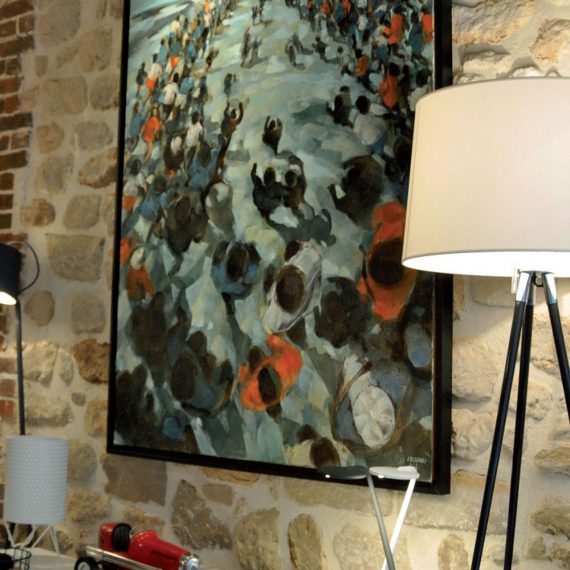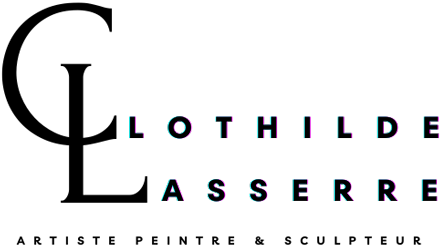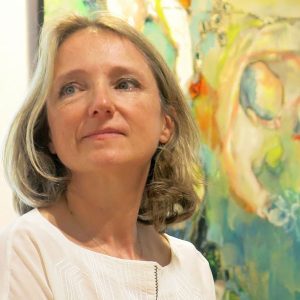
Clothilde Lasserre, French painter and sculptor
Clothilde Lasserre trained as a doctor of mathematics and has devoted herself entirely to her profession as a visual artist for the past 20 years. Colourful and symbolic, her work bears witness to the need for people to cultivate their individuality while living together.
The source of inspiration
Nourished by her experience of the human mass seen from the towers of La Défense in Paris, Clothilde Lasserre has gradually built up her vision of the world from above. Staging the crowd from above becomes her way of reappropriating this everyday life. Through her paintings and ceramics, the artist expresses her vision of human relationships. Links are forged, encounters materialise and give us faith in others.
‘Multitude, solitude: equal and convertible terms for the active and fertile poet. He who does not know how to populate his solitude, does not know how to be alone in a busy crowd either’. Charles Baudelaire ‘Les foules’ Le spleen de Paris ou les petits poèmes en prose -1869
Une artiste reconnue
Presenting her work to the public since 2003, Clothilde Lasserre has since held numerous solo and group exhibitions in France and abroad, notably in Paris, Lille and Nantes, as well as in Brussels, Belgium.
Working on identity
Oscillating between figuration and abstraction, her compositions perfectly embody the tug-of-war between multitude and unity. She expresses the delicate balance between the need to preserve our individuality and our need for contact with others.
When asked ‘How do you know if your painting is finished? It seems that one more character or not wouldn’t make any difference’, the artist explains that each person is important to the coherence of the scene, and she describes the long work involved in achieving this balance. With conviction, she explains that we each have our place in society, and that we mustn’t let ourselves be overwhelmed by the feeling of being drowned out by too many people, the anxiety of the unknown or the artifice of meeting people on social networks.
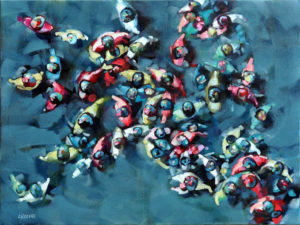
Porcelain and stoneware, a logical choice
The individual appears to be drowned in the multitude, but this is not the case.
With her, each individual regains their place in society, a network of humans all necessary to guarantee the balance of the whole!
‘Man is a sociable being; nature made him to live with his fellows’ Aristotle

From above, as seen by others
Clothilde Lasserre’s paintings are full of captivating energy.
Combining instinctive brushstrokes, bold colours and a relentless sense of composition, his Foules waltz between figuration and abstraction. A perpetual to-and-fro between an inner life and vital contact with the Other, brought to life by zooming in and out.
Clothilde Lasserre has been working on identity for a long time. The paradox of every individual: integrating and therefore not differentiating oneself while at the same time retaining one’s own individuality so as not to lose oneself.
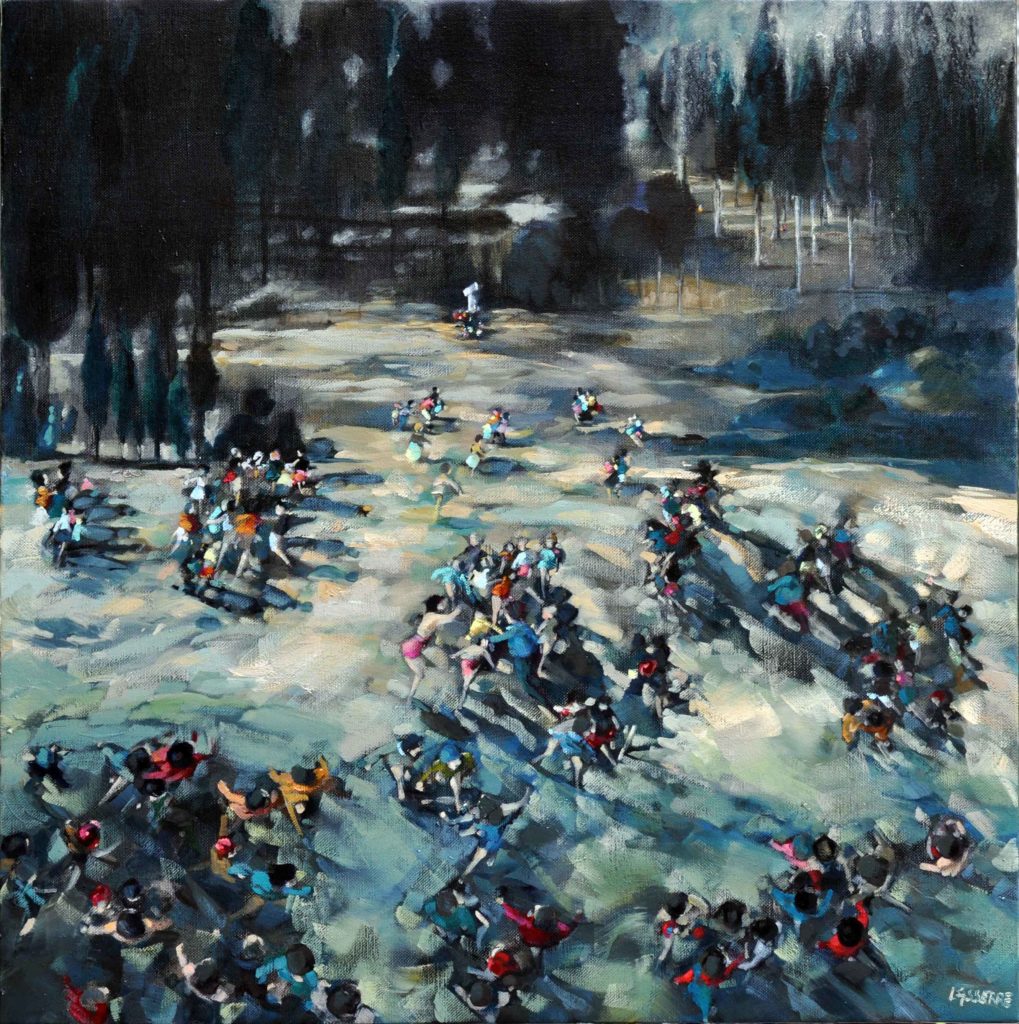
Verticality can make us hesitate:
It’s not really a bird’s eye view (generally a diagonal view or a perspective from a fairly close point of view), or a plane’s view (closer to the vertical and much further away), or from a star (the point of view of Sirius, which puts all the negative effects into perspective because it’s the closest star to the sun).
This would bring us to the divine point of view, which can also apprehend space without taking time into account (sub specie aeternitatis as Spinoza said, but this can also be a project for any human thinker). What makes Clothilde Lasserre’s vision possible is something else. There is a defamiliarised gaze, moving away from the face-to-face, very close to the vertical, if not a vertical gaze, but not very far away and taking movement into account. It is not, however, an aerial vision linked to the invention of aviation and the postcards that resulted from it.
This is a highly conceptual approach, a veritable ‘cosa mentale’, just as Leonardo’s was. We see things from above, but without any sign of domination. Because shifting the view in this way is a spiritual exercise.
Jean-François Clément
Clothilde Lasserre’s painting reflects an atypical path in the world of contemporary art.
She doesn’t come to painting by chance, but out of necessity. As the only means of expressing and sharing her understanding of the world, her exaltations and her anxieties. As her testimony to the difficulty of living together while being unique. His crowds are undoubtedly the finest expression of this. Crowds of individuals drowned in an alienating mass, but whose colours express so well the rich diversity of beings. And souls too.
Clothilde didn’t go to art school or even take painting lessons. She respects the masters but owes nothing to the teachers, and as a result she enjoys a great deal of freedom of expression. Her technique is strong, but it’s simply an extension of her aspiration to give colour to the emotions of our lives. With this innate sense of colour as her only reference point, Clothilde tackled oil on canvas straight away. From the outset, her brushwork appears powerful, her line rhythmic, but her light remains sensual. When people ask her what her style is, what category she fits into, she often replies ‘ah the boxes? Painting came to me to escape the world of boxes. I’m not going back either’. Marie Jouan Gondouin – Gallery owner
Despite this, her paintings are considered by art professionals to be figurative-expressionist, sometimes veering towards the abstract. Before becoming a painter, Clothilde was a mathematician. From this school of absolute rigour, she has integrated the power of symbols and the art of language into her work. Mathematics is a disciplined poetics, painting is a poetised discipline. Both help to tell the story of the world as it is, or as we would like it to be. His snowy landscapes owe a little to fractals, his crowds a lot to chaos theory. Or the story of a world that believes itself to be organised but which, on a simple impulse, tips over into panic, violence, jubilation or an unleashing of passion. It’s hardly surprising, then, that his works have met with enthusiastic response, particularly in China, a country of crowds if ever there was one.
Yet his main subject is not so much the crowd as Man and the fragility that prompts him to give up his individuality in order to feel less vulnerable. Her treatment of oil and colour helps to create urban scenes in which we first see the crowd over and over again, before her framing and lighting lead us to recognise ourselves as one in the midst of others. Clothilde’s work touches us because it speaks to each and every one of us.
